2019 DODGE CHARGER SRT engine overheat
[x] Cancel search: engine overheatPage 322 of 496
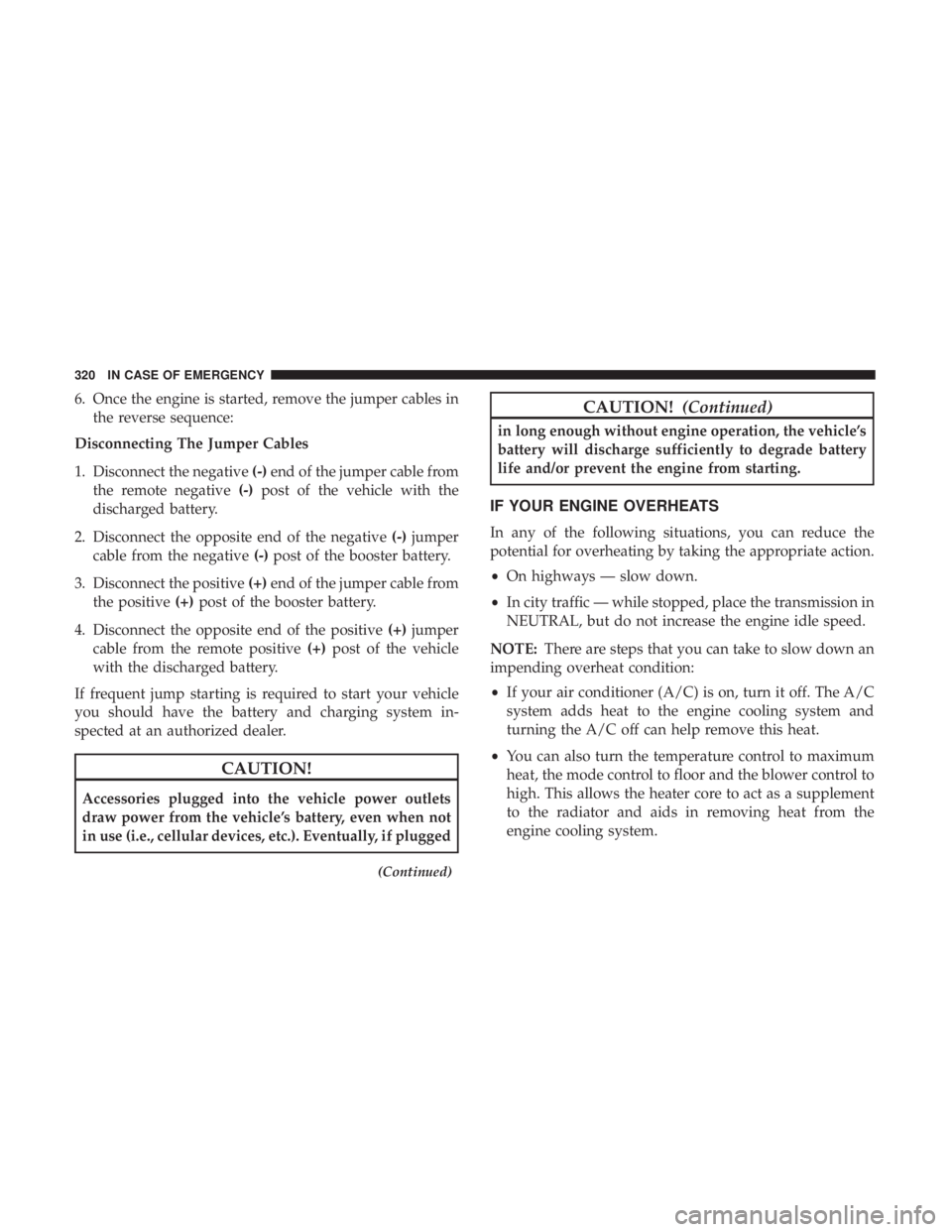
6. Once the engine is started, remove the jumper cables inthe reverse sequence:
Disconnecting The Jumper Cables
1. Disconnect the negative (-)end of the jumper cable from
the remote negative (-)post of the vehicle with the
discharged battery.
2. Disconnect the opposite end of the negative (-)jumper
cable from the negative (-)post of the booster battery.
3. Disconnect the positive (+)end of the jumper cable from
the positive (+)post of the booster battery.
4. Disconnect the opposite end of the positive (+)jumper
cable from the remote positive (+)post of the vehicle
with the discharged battery.
If frequent jump starting is required to start your vehicle
you should have the battery and charging system in-
spected at an authorized dealer.
CAUTION!
Accessories plugged into the vehicle power outlets
draw power from the vehicle’s battery, even when not
in use (i.e., cellular devices, etc.). Eventually, if plugged
(Continued)
CAUTION! (Continued)
in long enough without engine operation, the vehicle’s
battery will discharge sufficiently to degrade battery
life and/or prevent the engine from starting.
IF YOUR ENGINE OVERHEATS
In any of the following situations, you can reduce the
potential for overheating by taking the appropriate action.
•On highways — slow down.
• In city traffic — while stopped, place the transmission in
NEUTRAL, but do not increase the engine idle speed.
NOTE: There are steps that you can take to slow down an
impending overheat condition:
• If your air conditioner (A/C) is on, turn it off. The A/C
system adds heat to the engine cooling system and
turning the A/C off can help remove this heat.
• You can also turn the temperature control to maximum
heat, the mode control to floor and the blower control to
high. This allows the heater core to act as a supplement
to the radiator and aids in removing heat from the
engine cooling system.
320 IN CASE OF EMERGENCY
Page 326 of 496
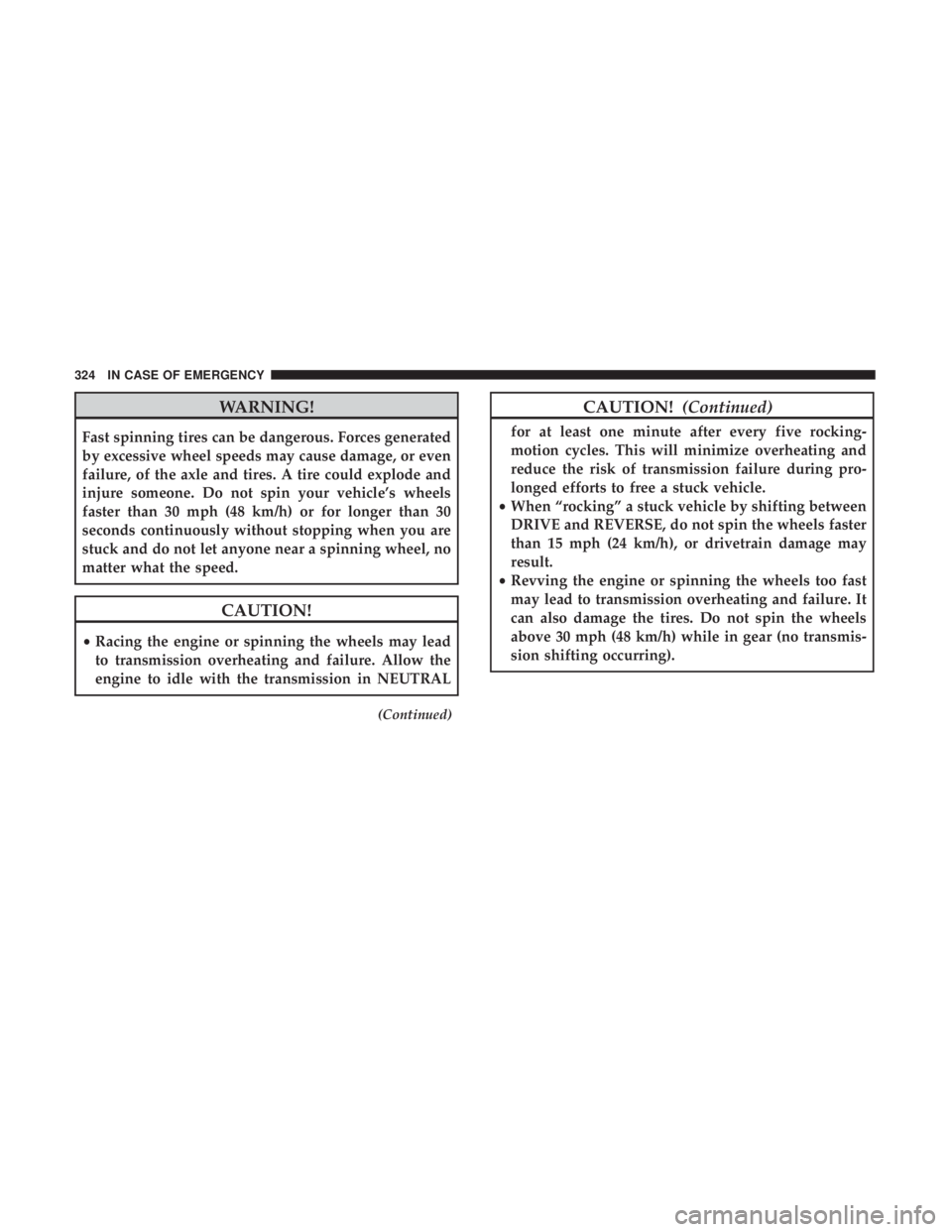
WARNING!
Fast spinning tires can be dangerous. Forces generated
by excessive wheel speeds may cause damage, or even
failure, of the axle and tires. A tire could explode and
injure someone. Do not spin your vehicle’s wheels
faster than 30 mph (48 km/h) or for longer than 30
seconds continuously without stopping when you are
stuck and do not let anyone near a spinning wheel, no
matter what the speed.
CAUTION!
•Racing the engine or spinning the wheels may lead
to transmission overheating and failure. Allow the
engine to idle with the transmission in NEUTRAL
(Continued)
CAUTION! (Continued)
for at least one minute after every five rocking-
motion cycles. This will minimize overheating and
reduce the risk of transmission failure during pro-
longed efforts to free a stuck vehicle.
• When “rocking” a stuck vehicle by shifting between
DRIVE and REVERSE, do not spin the wheels faster
than 15 mph (24 km/h), or drivetrain damage may
result.
• Revving the engine or spinning the wheels too fast
may lead to transmission overheating and failure. It
can also damage the tires. Do not spin the wheels
above 30 mph (48 km/h) while in gear (no transmis-
sion shifting occurring).
324 IN CASE OF EMERGENCY
Page 349 of 496
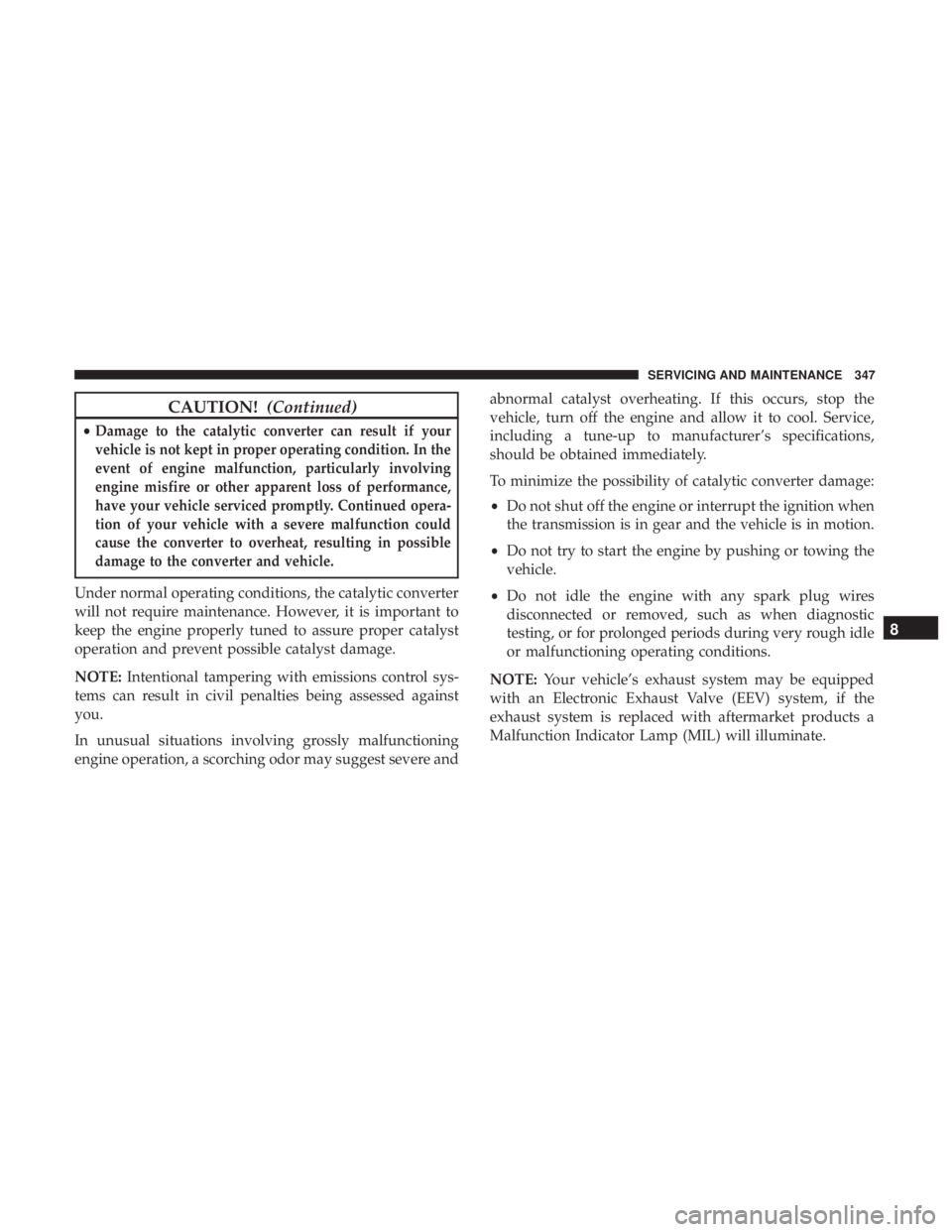
CAUTION!(Continued)
•Damage to the catalytic converter can result if your
vehicle is not kept in proper operating condition. In the
event of engine malfunction, particularly involving
engine misfire or other apparent loss of performance,
have your vehicle serviced promptly. Continued opera-
tion of your vehicle with a severe malfunction could
cause the converter to overheat, resulting in possible
damage to the converter and vehicle.
Under normal operating conditions, the catalytic converter
will not require maintenance. However, it is important to
keep the engine properly tuned to assure proper catalyst
operation and prevent possible catalyst damage.
NOTE: Intentional tampering with emissions control sys-
tems can result in civil penalties being assessed against
you.
In unusual situations involving grossly malfunctioning
engine operation, a scorching odor may suggest severe and abnormal catalyst overheating. If this occurs, stop the
vehicle, turn off the engine and allow it to cool. Service,
including a tune-up to manufacturer’s specifications,
should be obtained immediately.
To minimize the possibility of catalytic converter damage:
•
Do not shut off the engine or interrupt the ignition when
the transmission is in gear and the vehicle is in motion.
• Do not try to start the engine by pushing or towing the
vehicle.
• Do not idle the engine with any spark plug wires
disconnected or removed, such as when diagnostic
testing, or for prolonged periods during very rough idle
or malfunctioning operating conditions.
NOTE: Your vehicle’s exhaust system may be equipped
with an Electronic Exhaust Valve (EEV) system, if the
exhaust system is replaced with aftermarket products a
Malfunction Indicator Lamp (MIL) will illuminate.
8
SERVICING AND MAINTENANCE 347
Page 353 of 496
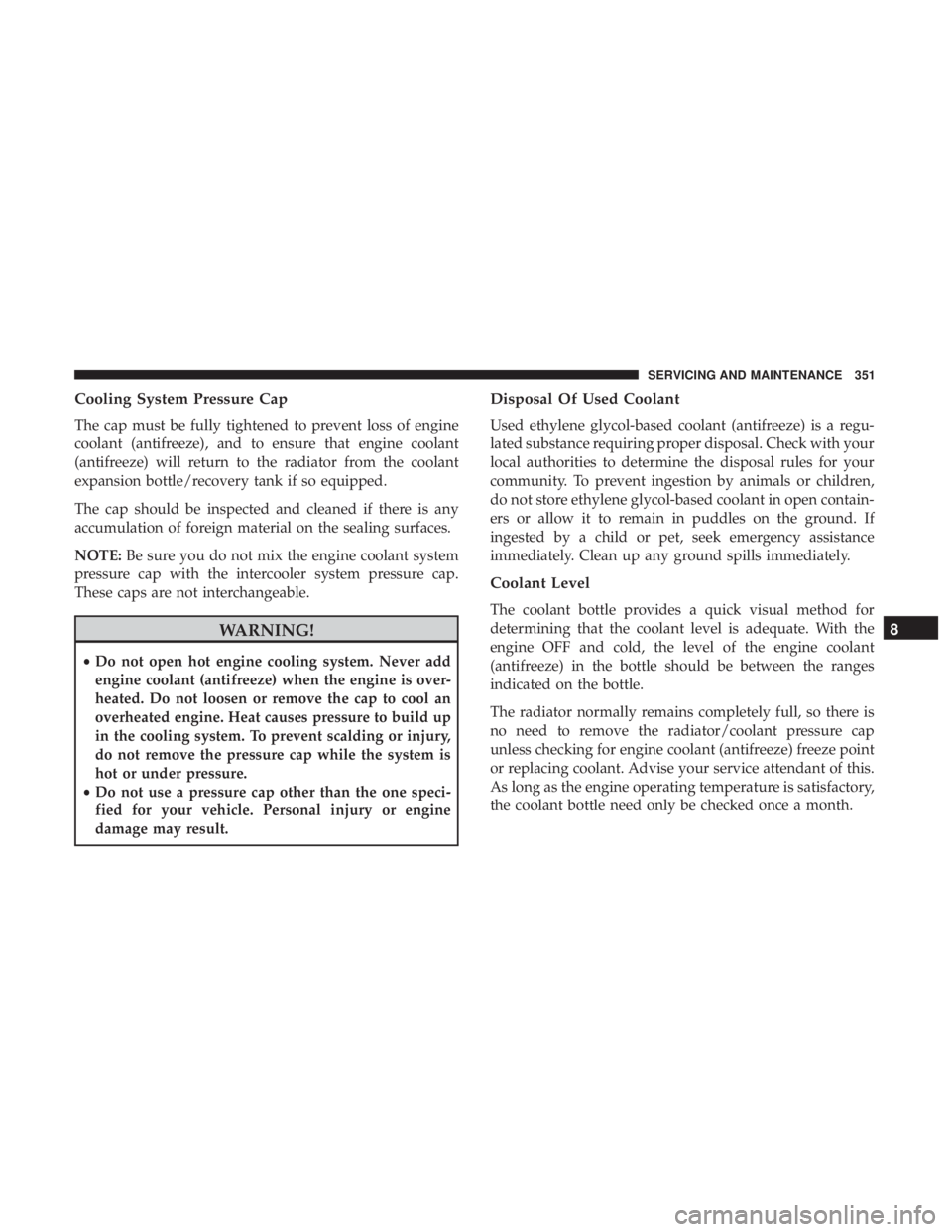
Cooling System Pressure Cap
The cap must be fully tightened to prevent loss of engine
coolant (antifreeze), and to ensure that engine coolant
(antifreeze) will return to the radiator from the coolant
expansion bottle/recovery tank if so equipped.
The cap should be inspected and cleaned if there is any
accumulation of foreign material on the sealing surfaces.
NOTE:Be sure you do not mix the engine coolant system
pressure cap with the intercooler system pressure cap.
These caps are not interchangeable.
WARNING!
• Do not open hot engine cooling system. Never add
engine coolant (antifreeze) when the engine is over-
heated. Do not loosen or remove the cap to cool an
overheated engine. Heat causes pressure to build up
in the cooling system. To prevent scalding or injury,
do not remove the pressure cap while the system is
hot or under pressure.
• Do not use a pressure cap other than the one speci-
fied for your vehicle. Personal injury or engine
damage may result.
Disposal Of Used Coolant
Used ethylene glycol-based coolant (antifreeze) is a regu-
lated substance requiring proper disposal. Check with your
local authorities to determine the disposal rules for your
community. To prevent ingestion by animals or children,
do not store ethylene glycol-based coolant in open contain-
ers or allow it to remain in puddles on the ground. If
ingested by a child or pet, seek emergency assistance
immediately. Clean up any ground spills immediately.
Coolant Level
The coolant bottle provides a quick visual method for
determining that the coolant level is adequate. With the
engine OFF and cold, the level of the engine coolant
(antifreeze) in the bottle should be between the ranges
indicated on the bottle.
The radiator normally remains completely full, so there is
no need to remove the radiator/coolant pressure cap
unless checking for engine coolant (antifreeze) freeze point
or replacing coolant. Advise your service attendant of this.
As long as the engine operating temperature is satisfactory,
the coolant bottle need only be checked once a month.
8
SERVICING AND MAINTENANCE 351
Page 393 of 496

MMT In Gasoline
Methylcyclopentadienyl Manganese Tricarbonyl (MMT) is
a manganese-containing metallic additive that is blended
into some gasoline to increase octane. Gasoline blended
with MMT provides no performance advantage beyond
gasoline of the same octane number without MMT. Gaso-
line blended with MMT reduces spark plug life and
reduces emissions system performance in some vehicles.
The manufacturer recommends that gasoline without
MMT be used in your vehicle. The MMT content of
gasoline may not be indicated on the gasoline pump;
therefore, you should ask your gasoline retailer whether
the gasoline contains MMT. MMT is prohibited in Federal
and California reformulated gasoline.
Fuel System Cautions
CAUTION!
Follow these guidelines to maintain your vehicle’s
performance:
•The use of leaded gasoline is prohibited by Federal
law. Using leaded gasoline can impair engine perfor-
mance and damage the emissions control system.
(Continued)
CAUTION! (Continued)
•An out-of-tune engine or certain fuel or ignition
malfunctions can cause the catalytic converter to
overheat. If you notice a pungent burning odor or
some light smoke, your engine may be out of tune or
malfunctioning and may require immediate service.
Contact an authorized dealer for service assistance.
• The use of fuel additives, which are now being sold
as octane enhancers, is not recommended. Most of
these products contain high concentrations of metha-
nol. Fuel system damage or vehicle performance
problems resulting from the use of such fuels or
additives is not the responsibility of the manufac-
turer and may void or not be covered under the New
Vehicle Limited Warranty.
NOTE: Intentional tampering with the emissions control
system can result in civil penalties being assessed against
you.
9
TECHNICAL SPECIFICATIONS 391
Page 484 of 496
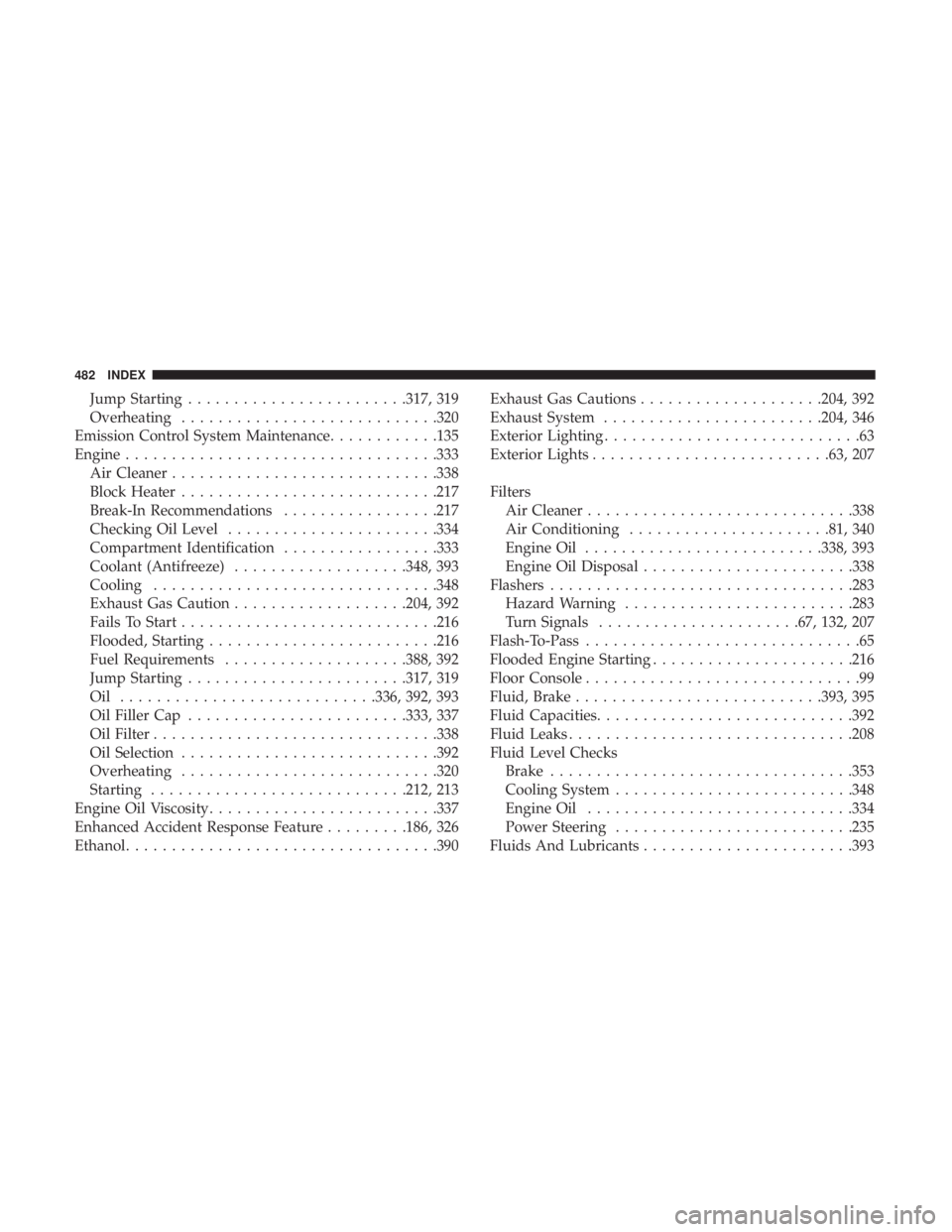
Jump Starting....................... .317, 319
Overheating ........................... .320
Emission Control System Maintenance ............135
Engine ................................. .333
Air Cleaner ............................ .338
Block Heater ........................... .217
Break-In Recommendations .................217
Checking Oil Level ...................... .334
Compartment Identification .................333
Coolant (Antifreeze) ...................348, 393
Cooling .............................. .348
Exhaust Gas Caution ...................204, 392
Fails To Start ........................... .216
Flooded, Starting ........................ .216
Fuel Requirements ....................388, 392
Jump Starting ....................... .317, 319
Oil ........................... .336, 392, 393
Oil Filler Cap ....................... .333, 337
Oil Filter .............................. .338
Oil Selection ........................... .392
Overheating ........................... .320
Starting ........................... .212, 213
Engine Oil Viscosity ........................ .337
Enhanced Accident Response Feature .........186, 326
Ethanol ................................. .390Exhaust Gas Cautions
....................204, 392
Exhaust System ....................... .204, 346
Exterior Lighting ............................63
Exterior Lights ......................... .63, 207
Filters Air Cleaner ............................ .338
Air Conditioning ..................... .81, 340
Engine Oil ......................... .338, 393
Engine Oil Disposal ...................... .338
Flashers ................................ .283
Hazard Warning ........................ .283
T
urn Signals ..................... .67, 132, 207
Flash-To-Pass ..............................65
Flooded Engine Starting ..................... .216
Floor Console ..............................99
Fluid, Brake .......................... .393, 395
Fluid Capacities ........................... .392
Fluid Leaks .............................. .208
Fluid Level Checks Brake ................................ .353
Cooling System ......................... .348
Engine Oil ............................ .334
Power Steering ......................... .235
Fluids And Lubricants ...................... .393
482 INDEX
Page 488 of 496
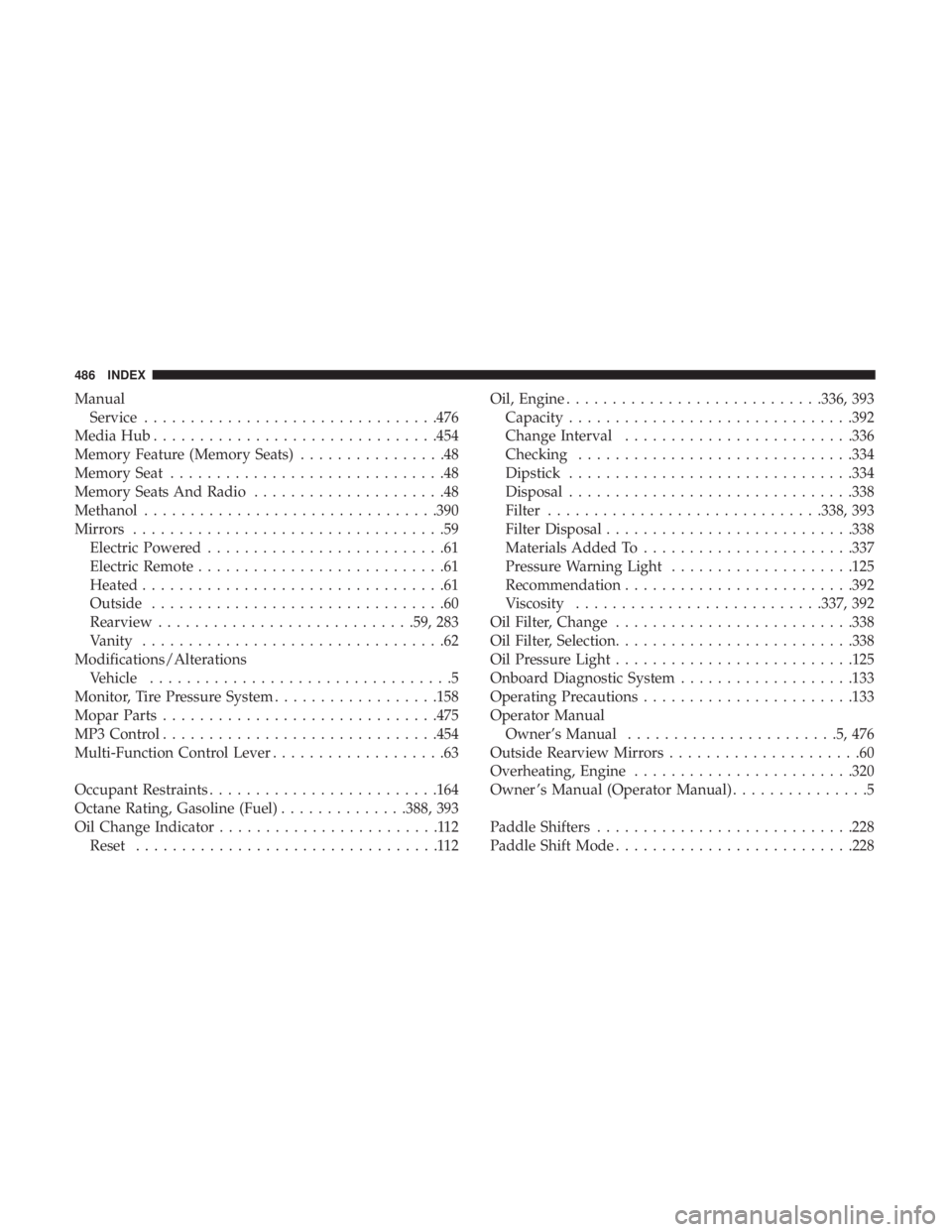
ManualService ............................... .476
Media Hub .............................. .454
Memory Feature (Memory Seats) ................48
Memory Seat ..............................48
Memory Seats And Radio .....................48
Methanol ............................... .390
Mirrors ..................................59
Electric Powered ..........................61
Electric Remote ...........................61
Heated .................................61
Outside ................................60
Rearview ........................... .59, 283
Vanity .................................62
Modifications/Alterations Vehicle .................................5
Monitor, Tire Pressure System ..................158
Mopar Parts ............................. .475
MP3 Control ............................. .454
Multi-Function Control Lever ...................63
Occupant Restraints ........................ .164
Octane Rating, Gasoline (Fuel) ..............388, 393
Oil Change Indicator ........................112
Reset .................................112 Oil, Engine
........................... .336, 393
Capacity .............................. .392
Change Interval ........................ .336
Checking ............................. .334
Dipstick .............................. .334
Disposal .............................. .338
Filter ............................. .338, 393
Filter Disposal .......................... .338
Materials Added To ...................... .337
Pressure Warning Light ....................125
Recommendation ........................ .392
Viscosity .......................... .337, 392
Oil Filter, Change ......................... .338
Oil Filter, Selection ......................... .338
Oil Pressure Light ......................... .125
Onboard Diagnostic System ...................133
Operating
Precautions ...................... .133
Operator Manual Owner’s Manual .......................5,476
Outside Rearview Mirrors .....................60
Overheating, Engine ....................... .320
Owner ’s Manual (Operator Manual) ...............5
Paddle Shifters ........................... .228
Paddle Shift Mode ......................... .228
486 INDEX